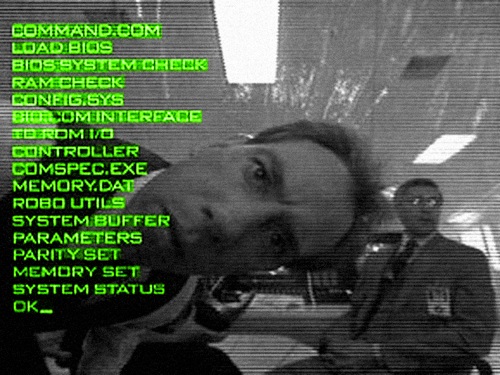Space Replaced by Machines
 [Image: From Robocop, via Quiet Babylon].
[Image: From Robocop, via Quiet Babylon].Architecture and technology blogger Tim Maly of Quiet Babylon fame has declared September 2010 Cyborg Month.
In the September 1960 issue of Astronautics magazine, he explains, theoreticians Manfred Clynes and Nathan Kline published a short paper called "Cyborgs and Space.” As Maly points out, "Aside from an early mention in the New York Times, this is the first time the word appears in print":
- September 1960. That’s 50 years ago. To commemorate, I’ve organized a project called “50 Posts About Cyborgs.” Over the course of the month, a whole gaggle of people have agreed to put up work ruminating on the use and abuse of the term.
On the other hand, you might be asking, what's a cyborg?
 [Image:
[Image: Intriguingly, at the origin of the term we find a kind of anti-architecture. The word cyborg was coined in 1960, Maly reminds us, which was "the era of the Cold War and the Space Race":
- NASA is not yet two years old. Sputnik is not yet three. Kennedy is a year away from announcing America’s commitment to putting a man on the moon. A lot of people were getting together and asking, “How can we survive for the long term in space?” One solution is architectural. Using the latest construction techniques, you can build a little bubble of earth, and plunk it down on any old alien world. We can send people off to these environments and so long as the walls don’t burst and the air doesn’t run out, they’ve got all the comforts of home. A pair of scientists, Manfred Clynes and Nathan Kline, had a different idea. “What if we could just live in space?” they asked, “What if instead of adapting the environment to ourselves, we adapted ourselves to the environment?” To do that, they reasoned, you need a cybernetic feedback system to maintain homeostasis unconsciously. These systems need to become a part of the organism. A cybernetic organism. A Cyborg.
 [Image: A "zombie ant" controlled by fungal brain parasites].
[Image: A "zombie ant" controlled by fungal brain parasites].So what, then, is cyborg architecture—if, in the present context, there can really be such a thing? Would it be a cybernetic network or a living geotextile? And if a house is a machine for living in, then perhaps Le Corbusier was a cyborg, too. Scaling things up, what is a cyborg city—or urban planning in the cyborg vernacular? And what about cyborg landscapes and cyborg space, in its most fluid and abstract?
Unsurprisingly, Quiet Babylon has its own take on all this; a six-part series called "Cyborgs & Architects" is worth a read: Adaptation, Astronauts and Super Villains, Nomads and Homesteaders, Mobile Structures, The Invisible Infrastructure of Cyborgs, and 6 Points on a Continuum.
Stay tuned to Maly's monthlong experiment to see what sorts of question, answers, and scenarios pop up—and consider participating yourself, simply by writing a cyborg-themed blog post. If you do, get in touch with Quiet Babylon and join the conversation. After all, there's no reason "50 Posts About Cyborgs" can't become 62 posts, or 75...





Comments are moderated.
If it's not spam, it will appear here shortly!
The 'Machine Boy' is in an infants gas mask produced in the UK during the second world war. As the breathing of a small child was insufficient to draw air through the charcoal filter the respirator required continual pumping, by the rubber bellows in the womans hands.
Thanks, Jeremy!
"The cyborg is resolutely committed to partiality, irony, intimacy, and perversity. It is oppositional, utopian, and completely without innocence. No longer structured by the polarity of public and private, the cyborg defines a technological polis based partly on a revolution of social relations in the oikos, the household" -A Cyborg Manifesto
Sorry, I just felt that a post on cyborgs needed to have some mention of Donna Haraway :)
Post a Comment